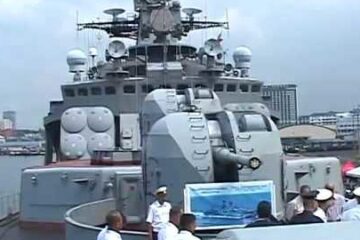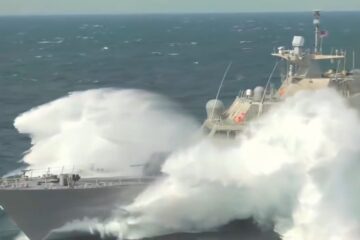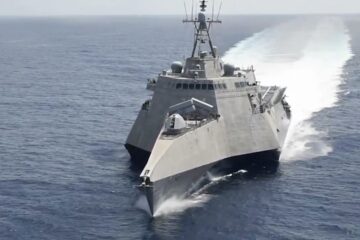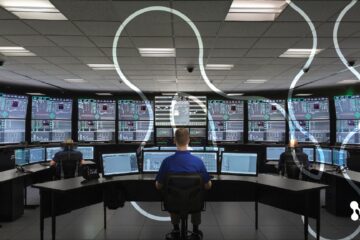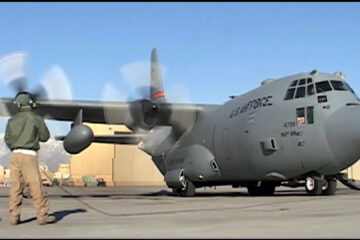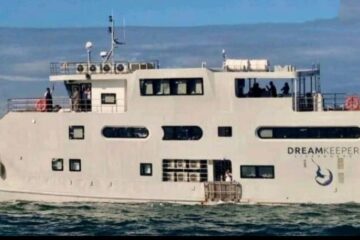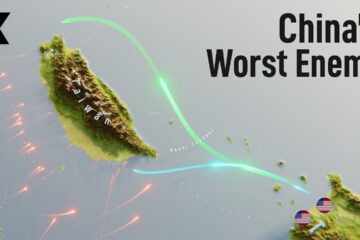The U.S. Missile Defense Agency and United States Navy sailors aboard the USS John Finn (DDG-113), an Aegis Ballistic Missile Defense (BMD) System-equipped destroyer, intercepted and destroyed a threat-representative Intercontinental Ballistic Missile (ICBM) target with a Standard Missile-3 (SM-3) Block IIA missile during a flight test demonstration in the broad ocean area northeast of Hawaii, November 16.
The ICBM target was launched from the Ronald Reagan Ballistic Missile Defense Test Site, located on Kwajalein Atoll in the Republic of the Marshall Islands. In this test, the destroyer used engage-on-remote capabilities through the Command and Control Battle Management Communications network to defend Hawaii. After receiving tracking data from the Command and Control Battle system, the destroyer launched an SM-3 Block 2A guided missile, which destroyed the target.
The United States Missile Defense Agency and United States Navy sailors aboard the USS John Finn (DDG-113), an Aegis Ballistic Missile Defense System-equipped destroyer, intercepted and destroyed a threat, the mock Intercontinental Ballistic Missile (ICBM) target with a Standard Missile-3 (SM-3) Block IIA missile during a flight test demonstration in the broad ocean area northeast of Hawaii, November 16.
As the U.S. Navy intercepted a dummy intercontinental ballistic missile from a destroyer in the Pacific, it potentially weakens the threat professed to the United States by North Korea or China.
China Respons on ICBM Test Response
But a Hong Kong-based military commentator Song Zhongping said the SM-3 Block 2A could not stop Chinese missiles like the DF-41 ICBMs and DF-26B intermediate-range ballistic missiles of their superior maneuverability and rapid trace changes in flight.
The SM-3 capability against a DF-41 is very limited, but it would be a threat to ICBMs developed by North Korea and Iran, the Hongkong commentator said.
The SM-3 Block IIA was jointly developed by Raytheon and Japan’s Mitsubishi Heavy Industries. In August 2019, the U.S. approved the sale of up to 73 SM-3 IIA missiles to Japan for an estimated US$3.3 million. The weapons will be installed at two sites in the East Asian country and expected to become operational in 2025.
The missile launches occur at a time of tremendous pressure between China and America due to the United States increasing military ties with Taiwan and conducting more frequent freedom of navigation operations in the disputed South China Sea, where China’s action has been increasingly aggressive.
Reactivation 1st fleet revival
The Pentagon is planning to reactivate the United States Navy’s 1st Fleet. The First Fleet was in operation from January 1947 to February 1973 in the western Pacific Ocean as part of the Pacific Fleet. It was disbanded, and its duties were assumed by the United States Third Fleet. The plan activation of the United States Navy 1st Fleet is to reinforce action against China’s aggressiveness.
The 7th Fleet at Yokosuka, comprising around 80 ships and submarines and up to 150 aircraft, has the most significant responsibility of all the United States Navy fleets. It covers more than 77 million square kilometers from Western Pacific up to the Indian Ocean.
The proposal for a new 1st Fleet command was announced by United States Navy Secretary Kenneth Braithwaite. The action is believed to be necessary to ease the burden on the 7th Fleet.
But as of now, the possible location of this Fleet is scholarly studied.
If the plans are approved, the Philippines and Singapore are the possible contenders as these countries already had an existing agreement.
But as for this situation, Subic Bay in the Philippines could be an alternative, although political support seems impossible.
Singapore is home to around 1,000 United States service members, civilians, and their families serving with Task Force 73 and Command Logistics Group Western Pacific, teams that arm, fuel, feed, and support 7th Fleet operations in the region and support U.S. littoral combat ships stationed there since 2013.
Last year, the United States renewed the three-decade-old pact between the United States and Singapore that grants United States forces access to naval and air bases. However, supporting this Fleet would require an informed judgment as hosting with this Fleet included a carrier strike group.
2nd Fleet Reactivation
In 2018, the 2nd Fleet was reactivated to counter Russian threats. The Fleet will oversee and control operations in the Atlantic and Arctic oceans and have a limited role in training and certification of East Coast-based forces deploying around the globe, the release said.
The Second Fleet was deactivated in September 2011 in the sense of the United States Government’s observation that Russia’s potential threat had gone.
In December 2019, Defensenews.com reported the full operational capability of 2nd fleets that certifies command-and-control infrastructure and could be deployed on its assigned operations.
Duterte warns against playing a ‘dangerous game’ in South China SEA dispute.
Meanwhile, in the Philippines. President Duterte Address the 15th East Asia Summit by leaving a message with a severe warning against playing a dangerous game in the disputed territory. While calling ASEAN members to lower the tensions and adhering to international law in the region.
The President added that the country in ASEAN’s council must not be played by this country. In the same speech, the President maintained that the Asia Pacific must remain a region of peace “where the rule of law is supreme — where all countries are equal, neither pawns nor lackeys of any power.”
